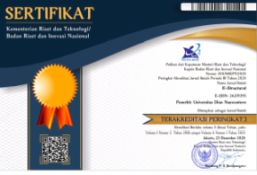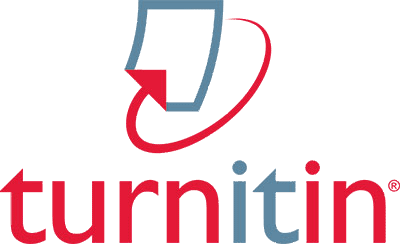Google Forms: An Assessment Tool Accommodating the Generation-Z Students’ Learning Needs
Abstract
Abstract. The study employed qualitative approach because the data were students’ responses on Google Forms, and students’ midterm score. It was aimed to exploring the use of Google forms in assessing students’ knowledge of the materials of Introduction to Linguistics. The materials were given until the sixth meetings in the Odd Semester of 2019/2020 were linguistics, the phonological term, pronunciation of certain words, the morphological formation and construction. Eleven questions on Google forms were in multiple choice, checkbox, multiple choice/checkbox grid, and short answer. The study has found that most of the students in Class A and Class B firstly used Google forms as the assessment tool with duration was set. Google form is useful for the teacher and students because it provides automatic calculation which enables effective and efficient feedback for the students to learn their mistakes. The study also found that auto grading on Google forms only calculates the correct answers which marked in the answer key feature. Thus, it would be suitable for grading questions in multiple choice and multiple choice grid, questions in checkboxes, short answer, and checkbox grid still needs manual grading. After comparing the score of assessment on Google Forms and midterm test, it can be concluded that students’ score was improved significantly after the assessment.
Keywords: Google Forms, assessment, generation-Z, students’ learning needs
Abstrak. Penelitian in imenggunakan pendekatan kualitatif mengingat data yang digunakan adalah respon mahasiswa dari Google Form, dan nilai Ujian Tengah Semester Mahasiswa. Penelitian ini bertujuan untuk mengetahui penggunaan Google form dalam menial pengetahuan mahasiswa akan materi mata kuliah Introduction to Linguistics. Materi-materi yang siberian hinge minggu keenam di Semester Ganjil than ajaran 2019/2020 adalah linguistik, istilah fonologi, pengucapan kata-kata tertentu, pembentukan dan konstruksi morfologis. Sebelas pertanyaan di Google Forms dalam bentuk pilihan ganda, kotak centang, kisi pilihan ganda/kotak centang, dan jawaban singkat. Penelitian ini telah menemukan bahwa sebagian besar mahasiswa Kelas A dan Kelas B baru pertama kali menggunakan Google Forms sebagai alat penilaian dengan durasi yang telah ditetapkan. Pada praktinya, Google Forms berguna bagi dosen dan mahasiswa karena adanya penghitungan otomatis yang memungkinkan umpan balik yang efektif dan efisien kepada mahasiswa untuk mempelajari kekeliruan mereka.Penelitian ini juga menemukan bahwa penilaian otomatis Google Forms hanya menghitung jawaban benar yang ditandai di figure kunci jawaban. Sehingga, penghitungan nilai hanya berlaku pada sol dengan pilihan ganda dan kisi pilihan ganda, penghitungan nilai secara manual masih harus dilakukan pada sol dalam bentuk kotak centang, kisi kotak centang dan jawaban singkat. Setelah membandingkan nilai pada Google Forms dan Ujian Tengah Semester, ditemukan bahwa nilai mahasiswa meningskat cukup signifikan setelah penilaian dengan Google Forms.
Kata kunci: Google Forms, penilaian, generasi-Z, kebutuhan pembelajaran mahasiswa.Full Text:
PDFReferences
Aalaei, S., Ahmadi, M. A. T., & Aalaei, A. (2016). A Comparison of Multiple-Choice and Essay Questions in the Evaluation of Dental Students. International Journal of Advanced Biotechnology and Research, 7(5), 1674–1680.
Alkamel, M. A., & Chouthaiwale, S. S. (2018). The Use of ICT Tools in English Language Teaching and Learning: A Literature Review. Journal of English Language and Literature (JOELL), 5(2), 29–33.
Castro, S. (2018). Google Forms Quizzes and Substitution, Augmentation, Modification, and Redefinition (SAMR) Model Integration. Issues and Trends in Educational Technology, 6(1), 4–14. Retrieved from https://www.learntechlib.org/p/188257/
Cilliers, E. J. (2017). The Challenge of Teaching Generation Z. PEOPLE: International Journal of Social Sciences, 3(1), 188–198. https://doi.org/10.20319/pijss.2017.31.188198
Cohen, S. S. (2016). How Teachers Conceive Their Role When Working with Generation Z Pupils in a Technological Learning Environment (University of Derbyw). Retrieved from http://creativecommons.org/licenses/by/4.0/LinktoItemhttp://hdl.handle.net/10545/620659
Creswell, J. W. (2014). Research Design: Qualitative, Quantitative and Mixed Method Approaches (4th ed.). London: SAGE Publication Ltd.
Devi, K. S., Gouthami, E., & Lakshmi, V. V. (2019). Role of Social Media in Teaching – Learning Process. Journal of Emerging Technologies and Innovative Research, 6(1), 96–103. Retrieved from https://www.researchgate.net/publication/330497773_Role_of_Social_Media_in_Teaching-Learning_Process
Dunham, B., Yapa, G., & Yu, E. (2015). Calibrating the difficulty of an assessment tool: The blooming of a statistics examination. Journal of Statistics Education, 23(3), 1–33. https://doi.org/10.1080/10691898.2015.11889745
Fernández-Cruz, F. J., & Fernández-DÃaz, M. J. (2016). Generation Z’s Teachers and their Digital Skills. Comunicar, 24(46), 97–105. https://doi.org/10.3916/C46-2016-10
Guskey, T. R., & Anderman, E. M. (2013). In Search of a Useful Definition of M(201astery. Educational Leadership, 71(4), 18–23.
Haddad, R. J., & Kalaani, Y. (2014). Google forms: A Real-Time Formative Feedback Process for Adaptive Learning. 121st ASEE Annual Conference and Exposition, Conference Proceedings, (August 2006).
Handayani, F. (2016). Instagram as a Teaching Tool? Really? Proceedings of the Fourth International Seminar on English Language and Teaching (ISELT-4), 320–327.
Hidayati, T. (2016). Integrating ICT in English Language Teaching and Learning in Indonesia. JEELS, 3(1), 38–62.
Jabbarifar, T. (2009). the Importance of Classroom Assessment and Evaluation in Educational System. Proceedings of the 2nd International Conference of Teaching and Learning (ICTL 2009), 1–9. INTI University College, Malaysia THE.
Jones, V., Jo, J., & Martin, P. (2007). Future Schools and How Technology can be used to support Millennial and Generation-Z Students. ICUT (Proceedings B), (January), 886–891. Retrieved from http://www98.griffith.edu.au/dspace/handle/10072/19022
Kato, T., & Kambayashi, Y. (2016). Practice for Self-Regulatory Learning using Google Forms : Report and Perspectives. Information Englineering Express International Institute of Applied Informatics, 2(4), 11–20.
Kumara, B. T. G. S., Brahmana, A., & Paik, I. (2019). Bloom’s Taxonomy and Rules Based Question Analysis Approach for Measuring the Quality of Examination Papers. International Journal of Knowledge Engineering,5(1), 2–6. https://doi.org/10.18178/ijke.2019.5.1.111
Mohr, K. A. J., & Mohr, E. S. (2017). Understanding Generation Z Students to Promote a Contemporary Learning Environment. Journal on Empowering Teaching Excellence, 1(1), 84–94. https://doi.org/10.15142/T3M05T
Purwati, T. (2019). Using Mobile Application To Promote Autonomous Learning for Syntax Subject. E-Structural, 1(02), 142–153. https://doi.org/10.33633/es.v1i2.2142
Raju, N. V., & Harinarayana, N. S. (2018). Online Survey Tools : A Case Study of Google Forms. National Conference on "Scientific, Computational & Information Research Trends in Engineering, (December).
Salas-Morera, L., Arauzo-Azofra, A., & GarcÃa-Hernández, L. (2012). Analysis of Online Quizzes As a Teaching and Assessment Tool. Journal of Technology and Science Education, 2(1). https://doi.org/10.3926/jotse.30
DOI: https://doi.org/10.33633/es.v2i2.3257
Article Metrics
Abstract view : 1477 timesPDF - 1004 times
Refbacks
- There are currently no refbacks.
Accredited by:
Indexed by:
In Collaboration with:

This work is licensed under a Creative Commons Attribution 4.0 International License.

























